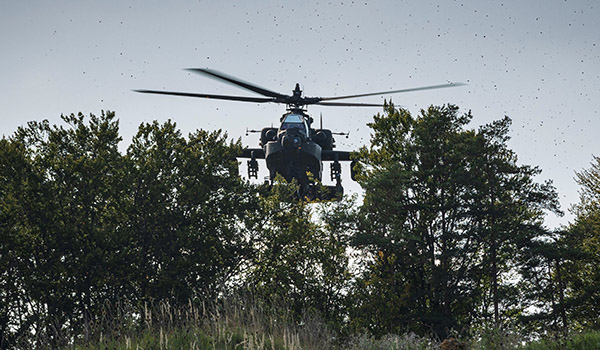
Branch Chief’s Corner / By MG David J. Francis: There is a reason the Army has selected six priority systems as the centerpiece of the Army modernization strategy.

An AH-64 Apache attack helicopter with the 1st Squadron, 6th Cavalry Regiment, 1st Combat Aviation Brigade, 1st Infantry Division hovers just over the tree line to mask itself against ground observation, as part of the culminating force on force exercise of Combined Resolve XII at the Joint Multinational Readiness Center in Hohenfels, Germany Aug. 22, 2019. Combined Resolve is a biannual U.S. Army Europe and 7th Army Training Command-led exercise intended to evaluate and certify the readiness and interoperability of U.S .forces mobilized to Europe in support of Atlantic Resolve. / U.S. ARMY PHOTO BY SGT THOMAS MORT
Each of these systems provides specific capabilities that when employed as a single combined arms capability is what we need to retain overmatch.
In the same way, each of these systems has to bring together its own intrinsic capabilities that combine to facilitate its survival on an ever more complex and technical battlefield.
As a consequence of Army Aviation’s range, maneuverability, lethality, and the decisive results this combination historically delivers, we also present a complex problem to the enemy. They in turn continuously search for ways to neutralize the threat of our aircraft systems. This adversarial to-and-fro has gone on since Army Aviation’s introduction to the battlefield.
A comprehensive understanding of our enemy’s actual capabilities has always driven innovative experimentation and approaches to countering the threat, approaches that are modeled, further developed in simulation and prototyped for further testing. This process has driven the creation of some of the most effective aircraft survivability equipment (ASE) in the world.
Threat detection and countermeasures are a critical part of aircraft survivability, but just as critical are the development and training of validated tactics, techniques and procedures (TTP) to employ these ASE systems. This is an enduring process that is conducted and shared to stakeholders across the Joint Force.
The most important aspect of this system is, and always has been, leadership. The decisive results that come from aviation have always been a result of leaders that understand their aircraft, understand their enemy, and thoroughly plan, rehearse and train to win.
Combine all aspects of survivability, the right equipment, realistic training, and sound leadership, and you have created the ability for Army Aviation to be decisive as part of the combined arms team, and ensure we maintain our competitive advantage in the next ‘first battle.’
Above the Best!
MG David J. Francis is the Army Aviation branch chief and commander of the U.S. Army Aviation Center of Excellence and Fort Rucker, AL.










